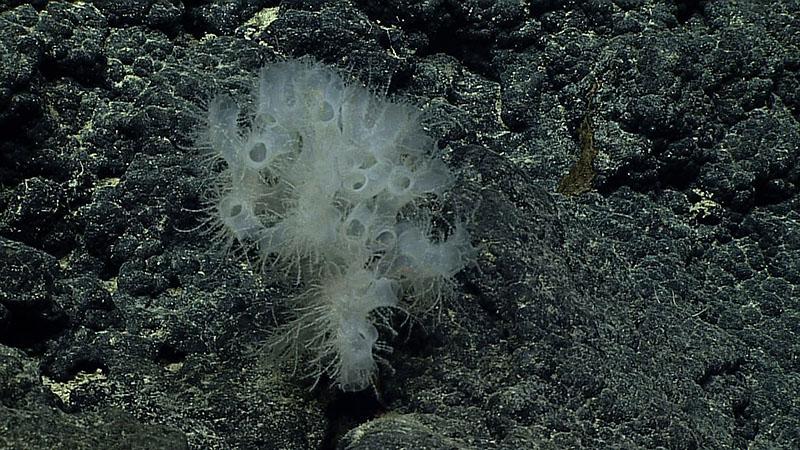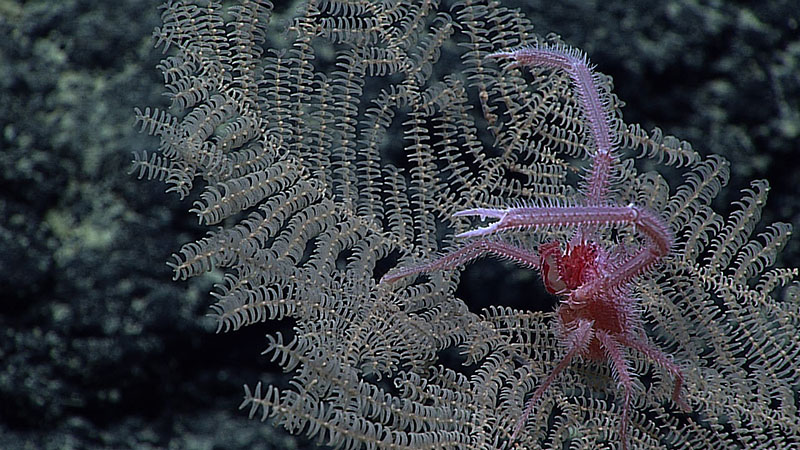Expeditions on NOAA Ship Okeanos Explorer Lead to Discovery of Three New Black Coral Species
November 11, 2020

This Antipathes sylospongia was overgrowing a glass sponge (Farrea occa) — look closely to see its branches peeking out — when it was collected at 1,299 meters (4,262 feet) in the Northwestern Hawaiian Islands, off Lisianski island during the 2015 Hohonu Moana expedition. The Greek species name “Sylospongia” is a nod to the coral’s sponge hosts. Image courtesy of the NOAA Office of Ocean Exploration and Research, 2015 Hohonu Moana. Download larger version (1.5 MB).
Given the vastness of our ocean, discoveries made while exploring the deep sea aren’t unusual, but they’re always exciting. Among recent discoveries are three previously unknown species of black coral: Antipathes sylospongia, Alternatipathes venusta, and Umbellapathes litocrada.
Black corals have dark skeletons, hence their name, but when alive they appear white, pink, or other colors because of the living tissue that grows on them. They can be difficult to differentiate from other species of coral, so to determine if a species is new to science, a sample must be collected and closely examined under a microscope.

Named for the Latin word meaning beautiful, this Alternatipathes venusta was collected at 2,638 meters (8,655 feet) on McCall Seamount in the Hawaiian Islands during the 2015 Hohonu Moana expedition. Image courtesy of the NOAA Office of Ocean Exploration and Research, 2015 Hohonu Moana. Download larger version (1.6 MB).
Most of the original samples (or “holotypes”) and photographs used to describe these new species were collected while exploring deep-sea seamounts and ridges around the Hawaiian Islands and Johnston Atoll in the North Pacific during CAPSTONE (Campaign to Address Pacific monument Science, Technology, and Ocean NEeds) expeditions aboard NOAA Ship Okeanos Explorer1. Scientists Dennis Opresko of the Smithsonian Institution and Daniel Wagner of Conservation International described the new species in a recent article in the peer-reviewed scientific journal Zootaxa.

Collected at 1,529 meters (5,016 feet) on Hutchinson Seamount, South of Johnston Atoll, Umbellapathes litocrada got its name from the Greek “litos” meaning “simple” and “crada” meaning “branch.” The spiny squat lobster is likely also a new species, but a sample has yet to be collected. Image courtesy of the NOAA Office of Ocean Exploration and Research, 2015 Hohonu Moana. Download larger version (1.4 MB).
Found primarily in deep waters, black corals are economically, culturally, and ecologically important. Used traditionally for medicinal purposes and as jewelry in many cultures (black coral is the state gem of Hawaii), black corals also provide important shelter and habitat for many other deep-sea animals. Black corals are some of the longest living and slowest growing animals on Earth, which makes them, and the animals that depend on them, particularly vulnerable to disturbances of the seafloor and in the water column. All black corals are protected under the Convention on International Trade in Endangered Species of Wild Fauna and Flora and are also considered vulnerable marine ecosystem indicator species by several regional fishery management organizations.
Discoveries like these highlight how little we know about the ocean. With each animal discovered, we increase our understanding of ocean biodiversity, enabling us to better manage and protect ocean life and resources.
Access the article about the new species .
1 Other important contributors to the discoveries include the Hawaii Undersea Research Lab, the Ocean Exploration Trust, and the Monterey Bay Aquarium Research Institute.
Opresko, D.M. and D. Wagner. (2020). New species of black corals (Cnidaria: Anthozoa: Antipatharia) from deepsea seamounts and ridges in the North Pacific. Zootaxa 4868 (4): 543-559. https://doi.org/10.11646/zootaxa.4868.4.5